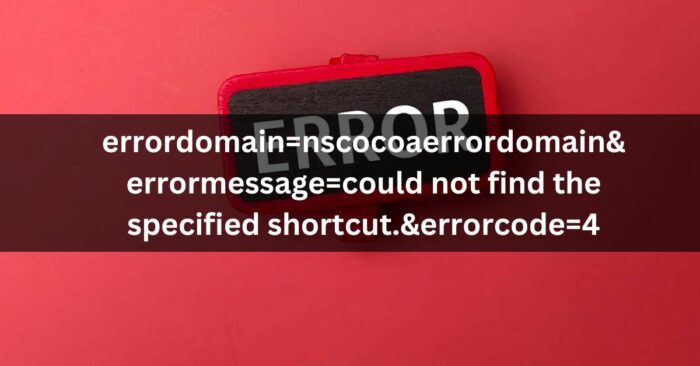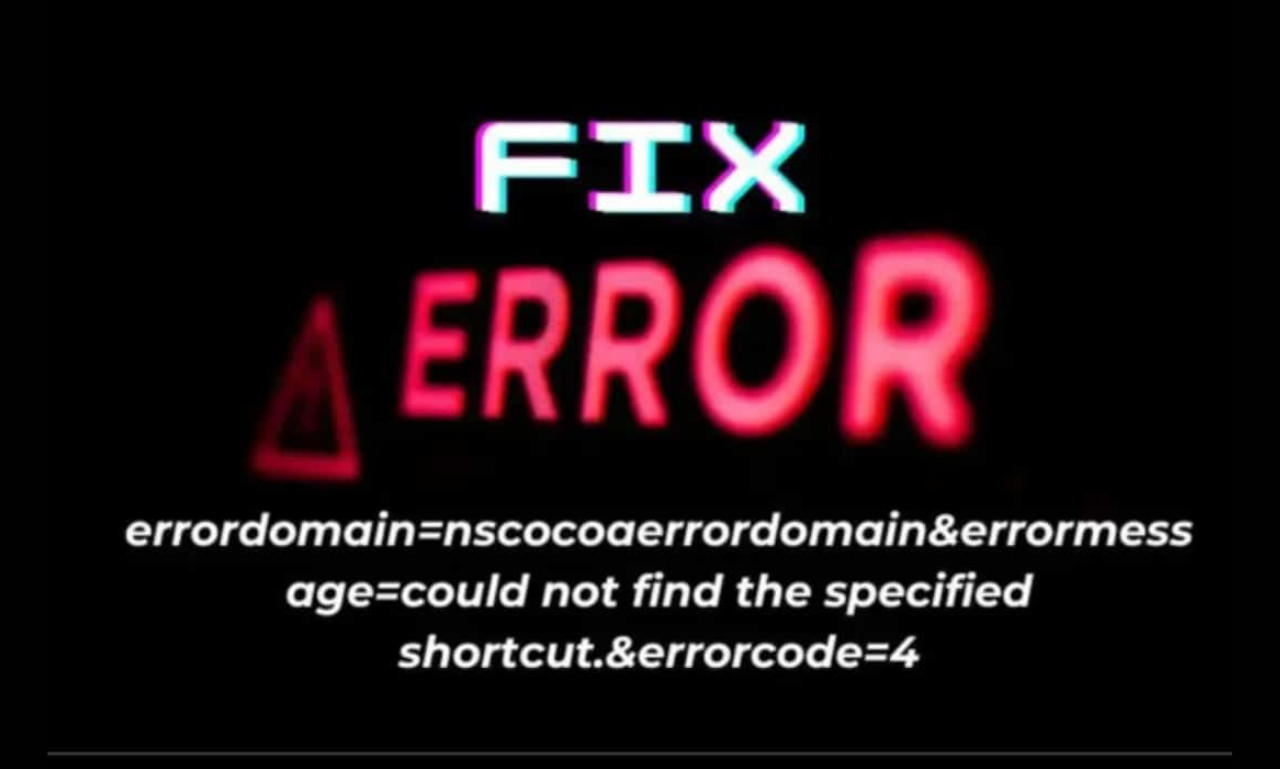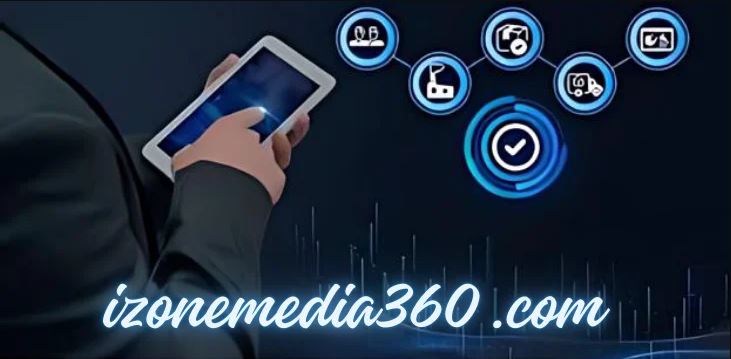Table of Contents
If you’re a Mac user or developer, you might have come across a frustrating error that reads: “errordomain=nscocoaerrordomain&errormessage=could not find the specified shortcut.&errorcode=4.” While the message seems long and complicated, the good news is that this error is relatively easy to fix. In this article, we’ll break down what the error means, explore its causes, and provide practical solutions to help you get back to a smooth user experience on your Mac.
What is the “Errordomain=nscocoaerrordomain&errormessage=could not find the specified shortcut.&errorcode=4” Error?

This specific error falls under the NSCocoaErrorDomain, which is related to Apple’s Cocoa framework—a foundation used in macOS for app development. The error message “could not find the specified shortcut” indicates that the operating system is unable to locate or recognize a certain keyboard shortcut or file. The error code “4” generally refers to a file-not-found issue.
In simpler terms, the system is trying to execute a command using a shortcut, but it can’t find the file or action associated with that shortcut.
Breaking Down the Error
Understanding this error becomes much easier when you break it down into three key components:
- ErrorDomain: This part refers to the framework or system that the error is associated with. In this case, it’s macOS’s Cocoa framework.
- ErrorMessage: The actual description of the problem, which, in this case, is that a specific shortcut can’t be found.
- ErrorCode: The error code “4” typically means that the system is unable to find a file, likely due to deletion, relocation, or corruption.
What Causes This Error?
There are several reasons why this error might occur. Here are the most common causes:
- MacOS Updates: Recent system updates may cause compatibility issues with existing shortcuts. If a shortcut is tied to an outdated or modified system function, it might not work after an update.
- Outdated Operating System: If your macOS is outdated, it could lack support for newer system functions or applications, leading to this error.
- Changed Shortcuts: If you or another user have recently changed a shortcut, the system might not recognize the new command.
- Conflicting Applications: Sometimes, two applications may conflict, causing one app’s shortcuts to override another’s.
- Missing Files: This happens when the file or resource you’re trying to access has been deleted, moved, or corrupted.
- External Factors: In rare cases, hardware malfunctions or issues with your internet connection might trigger this error.
Solutions to Fix “Errordomain=nscocoaerrordomain&errormessage=could not find the specified shortcut.&errorcode=4”
Now that you have a better understanding of what might be causing the error, let’s walk through some practical solutions. Try each one, starting from the top, and see which one resolves the issue for you.
1. Review Your Application’s Code (For Developers)
If you’re a developer and this error is popping up in an app you’re building, start by reviewing your code. Specifically, look at how your app handles shortcuts and file access. The error could be caused by a bug, incorrect input, or a lack of proper error handling mechanisms.
2. Update macOS
An outdated operating system can often lead to compatibility issues. Ensure that your macOS is updated to the latest version. Here’s how to check:
- Go to the Apple menu and click on System Preferences.
- Select Software Update.
- If an update is available, install it and restart your Mac.
By updating your system, you might resolve any bugs or issues that were causing the error.
3. Restore Missing Files
If you’re using a shortcut to access a file that no longer exists, this could trigger the error. Check to see if the file is still present on your system. If it’s been deleted, try restoring it from your backup. If the file is located in a different folder, move it back to its original location or update the shortcut to point to the new location.
4. Check for Conflicting Applications
Sometimes, two applications on your Mac might have conflicting shortcuts. To check if this is the case:
- Open System Preferences.
- Select Keyboard and click on the Shortcuts tab.
- Review all assigned shortcuts and see if the one you’re trying to use conflicts with another app. If necessary, change the conflicting shortcut.
5. Reboot Your Mac
A simple reboot can sometimes resolve many system errors, including this one. Restart your Mac and try using the shortcut again to see if the issue persists.
6. Clean Your Registry Keys
Corrupt or erroneous registry keys could be causing the error. While macOS doesn’t have a traditional registry like Windows, you can still clean up system caches and preferences that might be causing problems. Use a macOS cleaner app, or reset your NVRAM/PRAM:
- Shut down your Mac.
- Turn it back on while holding Option + Command + P + R.
- Release the keys after about 20 seconds, or when you hear the startup sound.
This process clears certain system settings and might fix issues related to shortcuts.
7. Scan for Viruses
Although macOS is generally secure, it’s still possible for malware or a virus to cause system errors. Install a trusted antivirus app, run a full system scan, and remove any detected threats. After scanning, try using the shortcut again to see if the issue is resolved.
8. Contact Customer Support
If none of the above solutions work, it might be time to contact Apple Support or the developer of the application that’s causing the error. Provide them with details of the error message and the steps you’ve already tried. They can offer further troubleshooting guidance or issue a patch if necessary.
How to Prevent the Error in the Future
Once you’ve fixed the error, you’ll want to take steps to prevent it from happening again. Here are a few tips to avoid running into this issue:
- Regularly Update Your macOS: Keeping your system updated helps avoid compatibility issues with shortcuts.
- Keep Files Backed Up: Always back up important files and resources so that you can restore them if they’re accidentally deleted or corrupted.
- Use a Reliable Antivirus: Having a good antivirus program can prevent malware and viruses from causing system errors.
- Avoid Unverified Software: Be cautious when installing third-party apps. Always check for reviews and scan for malware before installation.
Final Thoughts
The errordomain=nscocoaerrordomain&errormessage=could not find the specified shortcut.&errorcode=4 error may look daunting, but with the right steps, it’s easy to resolve. By understanding the causes, from missing files to system conflicts, and applying the troubleshooting solutions discussed, you can quickly get back to working without disruptions. Keep your system updated and regularly back up your data to avoid running into similar issues in the future.
Here are 10 frequently asked questions (FAQs) related to the article about Olympus Scanlation:
1. What is Olympus Scanlation?
Olympus Scanlation is the fan-driven process of translating Japanese manga into other languages before official translations are released. It allows readers to access manga content more quickly.
2. How does Olympus Scanlation work?
Olympus Scanlation involves acquiring raw scans of manga, translating the text, editing the artwork to incorporate translations, and sharing the final product online for fans to read.
3. Is Olympus Scanlation legal?
No, scanlation is often considered illegal because it involves distributing manga without permission from the original creators or publishers, bypassing the proper licensing process.
4. Why do fans support Olympus Scanlation?
Fans appreciate Olympus Scanlation for providing quick access to new manga chapters and offering translations of niche or less popular titles that may not get official releases.
5. How does scanlation impact the manga industry?
Scanlation can have a negative impact on the manga industry by reducing sales of official releases. Some argue that it takes away from the financial support that creators and publishers rely on.
6. Are scanlations lower quality than official translations?
While many fan scanlations are of high quality, some may contain errors or misinterpretations due to the lack of professional oversight, which can affect the reading experience.
7. How do scanlators choose which manga to translate?
Scanlators often select manga that has yet to be officially translated or is highly anticipated by the fan community. They may also focus on niche genres or lesser-known titles.
8. Where can I read Olympus Scanlation manga?
Fans can find scanlated manga on popular platforms like MangaDex, Bato.to, and other community-driven websites that host user-uploaded content.
9. Is there a way to support the original creators if I read scanlations?
Yes, fans who enjoy scanlations are encouraged to buy official releases, merchandise, or subscribe to official platforms when they become available, to support the creators and publishers.
10. Will scanlation continue to be relevant in the future?
As long as there is demand for immediate access to manga, scanlation is likely to continue. However, the growing number of official simultaneous translations may reduce the need for fan-driven scanlations in the long term.






